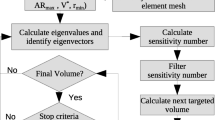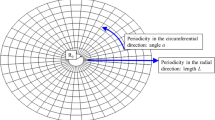Abstract
This paper discusses issues related to designing band-gaps in periodic plane grid structures. Finite element analysis is used to solve the dynamic behavior of a representative unit cell and Bloch–Floquet theory is used to extend the results to the infinite structure. Particular attention is given to the addition of non-structural masses that are introduced as design variables. These are used to create desirable features in the dispersion diagram. Physical insight is presented into the optimal choice of locations where masses should be added and the results of several numerical examples are provided to highlight this and other features of how band-gaps can be created and located at desired frequency ranges. The effect of the skew angle of the underlying grid structure is also explored, as are mathematical refinements of the modelling of the beam elements and the rotational inertia of the added masses. A scaling feature between the size of the reducible and the irreducible reference cell is exploited and the manner in which this can simplify optimization approaches is discussed.
Similar content being viewed by others
References
Brillouin Brillouin L (1953) Wave propagation in periodic structures. 2nd edn. New York: Dover
Cox00 Cox SJ, Dobson DC (2000) Band structure optimization of two-dimensional photonic crystals in H-polarization, J Comput Phys 158:214–224
Cox99 Cox SJ, Dobson DC (1999) Maximizing band-gaps in two-dimensional photonic crystals. SIAM J Appl Math 59:2108–2120
Diaz Diaz A, Benard A (2001) On the discretization of problems involving periodic planar tilings. Commun Numer Methods Eng 17:543–549
Dowling Dowling J, Everitt H (2004) Sonic band-gap bibliography, http://home.earthlink.net/∼jpdowling/pbgbib.html
Heckel Heckel MA (1964) Investigations on the vibrations of grillages and other simple beam structures J Acoust Soc Am 36:1335–1343
Jensen Jensen JS (2003) Phononic band-gaps and vibrations in one-and two-dimensional mass-spring structures. J Sound Vib 266:1053–1078
Kafesaki Kafesaki M, Sigalas MM, Economou EN (1995) Elastic wave band-gaps in 3-D periodic polymer matrix composites. Solid State Commun 96(5):285–289
Langlet Langlet P, Hladky-Hennion A-C, Decarpigny JN (1995) Analysis of the propagation of plane acoustic waves in passive periodic materials using the finite element method. J Acoust Soc Am 98:2792–2800
Ma Ma L, Diaz A, Haddow A (2004) Modeling and design of materials for controlled wave propagation in plane grid structures. Paper DETC2004-57183, Proc. of DETC’04, ASME 2004 Design Engineering Technical Conf., Salt Lake City, UT
Martinsson Martinsson PG, Movchan AB (2003) Vibrations of lattice structures and phononic band-gaps. Q J Mech Appl Math 56(1):45–64
Orris Orris RM, Petyt M (1974) A finite element study of harmonic wave propagation in periodic structures. J Sound Vib 33:223–236
Parmley Parmley S, Zobrist T, Clough T, Perez Miller A, Makela M, Yu R (1995) Phononic band structure in a mass chain. Appl Phys Lett 67(6):777–779
Sigalas Sigalas M, Economou E (1994) Elastic waves in plates with periodically placed inclusions. J Appl Phys 75(6):2845–2850
Sigmund Sigmund O (2001) Microstructural design of elastic band-gap structures. Proc. of the Second World Congress of Struct. and Multidisc. Optim., Dalian, China
SigmundJensen Sigmund O, Jensen JS (2002) Topology optimization of phononic band-gap materials and structures. Fifth World Congress on Computational Mechanics, Vienna, Austria
SigmundJensen03 Sigmund O, Jensen JS (2003) Systematic design of phononic band-gap materials and structures by topology optimization. Phil Trans R Soc Lon A 361:1001–1019
Svanberg Svanberg K (1987) The method of moving asymptotes. Int J Numer Mech Eng 24:459–373
Vasseur Vasseur JO, Deymier PA, Frantziskonis G, Hong G, Djafari-Rouhani B, Dobrzynski L (1998) Experimental evidence for the existence of absolute acoustic band-gaps in two-dimensional periodic composite media. J Phys Condens Matter 10:6051–6064
Author information
Authors and Affiliations
Corresponding author
Rights and permissions
About this article
Cite this article
Diaz, A., Haddow, A. & Ma, L. Design of band-gap grid structures. Struct Multidisc Optim 29, 418–431 (2005). https://doi.org/10.1007/s00158-004-0497-6
Received:
Published:
Issue Date:
DOI: https://doi.org/10.1007/s00158-004-0497-6




